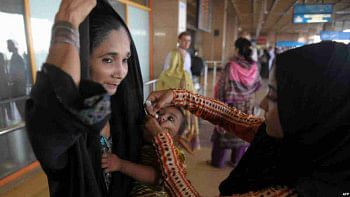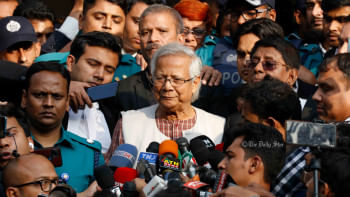“Our studies helped countless people all over the world”

Dr Md Khalequzzaman, a senior scientist and epidemiologist at icddr,b shares his insights on the fight against poliovirus, and Bangladesh's contribution to poliovirus vaccine research in an exclusive interview with Naimul Alam Alvi of The Daily Star.
Presently, polio has largely been non-existent for years, especially in Bangladesh. Do you consider the prevention of polio has been successful so far?
Yes, we have seen very positive results globally in containing polio. Wild poliovirus (the polio virus variant found in nature) types 2 and 3 (WPV2 and WPV3), were declared eradicated in 2015 and 2019 respectively. Now, there are only two countries where one variant of wild poliovirus is endemic – Pakistan and Afghanistan. And there too, these cases are sporadic and limited to specific geographical locations. There are now two polio-variants found called circulating vaccine-derived polioviruses (cVDPVs) and vaccine-associated paralytic polio (VAPP).
In Bangladesh, the last recorded case was back in 2006. We can safely say, Bangladesh has been a success story in polio awareness and vaccination drive. We are excited in the hopes that polio becomes the third disease to be eradicated from the world completely, after Smallpox and Rinderpest.
How have we been so successful with polio?
The first type of vaccine was licensed back in 1955 in the United States. It is an inactivated poliovirus vaccine (IPV). This type of vaccine is administered with injection. Subsequently, a new oral poliovirus vaccine (OPV) was licensed in 1961-62. There were three type-specific, live, attenuated OPVs. Because OPV is more cost-effective and easy to administer OPVs largely replaced IPV as the primary vaccine of choice for polio vaccination in most countries.
However, there are important disadvantages to OPV use. Because these vaccines contain live attenuated viruses, they can mutate inside the human body, and in some rare cases revert to a neurovirulent form leading to vaccine-associated paralytic polio (VAPP). Moreover, the viruses can circulate in areas where polio vaccination coverage is inadequate. Prolonged person-to-person transmission can, and in some cases has, resulted in mutations and the emergence of new variants of poliovirus – cVDPV, which have re-acquired the neurovirulence and transmissibility of wild poliovirus, and now, as I said, is the variant globally.
We can safely say, Bangladesh has been a success story in polio awareness and vaccination drive. We are excited in the hopes that polio becomes the third disease to be eradicated from the world completely, after Smallpox and Rinderpest.
Is OPV somewhat responsible for this new variant of poliovirus?
Yes, but we have to understand that, it is because of OPV which contains live attenuated virus, that we have been successful in covering a large population all over the world, even in hard-to-reach locations. It has helped to reduce polio cases worldwide dramatically. However, polio eradication will require an eventual cessation of all traditional OPVs.
How did iccdr,b play a role in polio eradication efforts?
icddr,b has been contributing in various ways in Global Polio Endgame strategies. Our scientists have conducted 22 polio vaccine trials. Many of the study research results have had global policy implications. Earlier the standard schedule of giving OPV doses was at 4 weeks intervals. However, our study found that a 2-week interval between doses induces a similar immune response. This is important because it makes administrating vaccines, especially in rural areas easier – regarding transportation, cold storage, vaccine management, and so on. It also helps to rapidly increase population immunity in case of outbreaks. This paper won the 2016 Charles C. Shepard Science Award from the CDC and is now being used for polio outbreak responses in Pakistan, Afghanistan, Syria, Laos and many more countries. Our studies also revealed that monovalent type 2 OPV, or mOPV2 can be administered at one or two-week intervals without impacting its humoral immunogenicity. This paper also won the Charles C. Shepard Science Award by the CDC in 2019. This strategy of administrating mOPV2 has been recommended to WHO by the Polio Strategic Advisory Group of Experts (SAGE), which I am a member of WHO has revised the global type 2 poliovirus outbreak response protocol, and recommended reducing the number of mOPV 2 campaigns from four to six weeks to two to three weeks. We have shown that two doses of fractional IPV (0.1 ml instead of 0.5 ml) given at 8 week intervals are more immunogenic than a single dose of IPV. This regimen is now being used in the Bangladesh EPI programme and also in India, Nepal and Sri Lanka. This was considered an important finding in the context of the global shortage of IPV.
Since traditional OPV, or what we call Sabin OPV is associated with vaccine-derived poliovirus, a novel type 2 OPV (nOPV2) has been developed which has proved to be more genetically stable and has no neurovirulence activity among both adults and children. We, from icddr,b, conducted for the first time a study on nOPV2 among the newborn population and we got positive results – it was proven to be safe and immunogenic. So, our results provided evidence that the vaccine is safe and well-tolerated in naive newborns, resulting in almost 99 percent of infants having protective neutralising antibodies. The vaccine has already been used in 700 million doses globally in outbreak response.
We are proud to say that Icddr,b has been one of the leading institutions in poliovirus drive all over the world.
You've mentioned Pakistan and Afghanistan are the two countries where wild polioviruses are still endemic. Do we have any additional risk being geographically close to these countries?
Certainly, we have to be more cautious because of our proximity to those regions. However, we have not seen outbreaks spreading across borders and towards us in recent times. Moreover, people now travel internationally way more than before, so the possibility of spreading a virus doesn't only depend on geographical proximity now. Nonetheless, we must always be careful about polio outbreaks, and the most powerful tool we have is surveillance. We need to continuously study and understand whether and how any virus is spreading.
As a member of the WHO Polio Research Committee, and also the Polio WHO Strategic Advisory Group of Experts, what should be our way forward in ensuring that polio never comes back?
Drives from WHO, along with countless institutions, scientists, governments and so on have been quite successful against polio. We have developed, and are improving our strategies for containing this disease effectively. However, there are still logistical, and sometimes political barriers. For instance, it is still difficult to provide adequate vaccination drives in certain places in Afghanistan and Pakistan. But, the situation is improving.
Our government has always been helpful in our efforts, and we are seeing the results. We have not only become an example of success but our studies and strategies have helped countless people all over the world.
I hope that we continue this trend and that the fight against polio and other vaccine preventable diseases be considered beyond political or geographical differences.
Follow The Daily Star Opinion on Facebook for the latest opinions, commentaries and analyses by experts and professionals. To contribute your article or letter to The Daily Star Opinion, see our guidelines for submission.

 For all latest news, follow The Daily Star's Google News channel.
For all latest news, follow The Daily Star's Google News channel. 









Comments